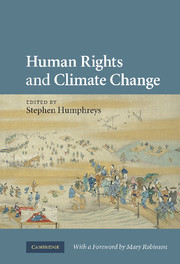Book contents
- Frontmatter
- Contents
- Authors' biographies
- Acronyms
- Acknowledgements
- Foreword
- Introduction: human rights and climate change
- PART I Rights perspectives on global warming
- PART II Priorities, risks and inequities in global responses
- 6 The Kyoto Protocol and vulnerability: human rights and equity dimensions
- 7 Forests, climate change and human rights: managing risks and trade-offs
- 8 Climate change and the right to the highest attainable standard of health
- 9 Human rights and vulnerability to climate change
- 10 Climate change, evolution of disasters and inequality
- Conclusion
- Appendix: climate change impacts on human rights
- Index
- References
9 - Human rights and vulnerability to climate change
from PART II - Priorities, risks and inequities in global responses
Published online by Cambridge University Press: 04 August 2010
- Frontmatter
- Contents
- Authors' biographies
- Acronyms
- Acknowledgements
- Foreword
- Introduction: human rights and climate change
- PART I Rights perspectives on global warming
- PART II Priorities, risks and inequities in global responses
- 6 The Kyoto Protocol and vulnerability: human rights and equity dimensions
- 7 Forests, climate change and human rights: managing risks and trade-offs
- 8 Climate change and the right to the highest attainable standard of health
- 9 Human rights and vulnerability to climate change
- 10 Climate change, evolution of disasters and inequality
- Conclusion
- Appendix: climate change impacts on human rights
- Index
- References
Summary
This chapter offers a sys`tematic examination of the connections between vulnerability to climate change and human rights. Vulnerability is a key concept in climate change research and policy. It is defined here as the degree to which people and the things that they value are susceptible to damage arising from climate change (adapted from Schneider et al. 2007).
There is at present only a very small body of academic scholarship that explicitly addresses the risks that climate change poses to human rights, and this is largely from theoretical (Sachs 2006) and legal perspectives (Juss 1998, Posner 2007, Sinden 2007). The topic has not been considered in any detail by the global environmental change research community as yet, although there has been some mention of climate impacts as a human rights issue (see, for example, Adger 2004, Barnett and Adger 2003), and there are points of commonality in entitlements-based approaches to vulnerability (for example, Adger and Kelly 1999, Bohle et al. 1994) and in the research on global environmental change and human security (see, for example, Barnett et al. 2007, O'Brien 2006).
The most substantial body of existing research on rights and climate change concerns the issue of mitigation of greenhouse gases (GHGs), the bulk of which is about rights-based approaches to reducing emissions. This research is for the most part concerned with property rights (things that can most often be exchanged), as distinct from human rights (which are most often inalienable) (Shue 1999).
- Type
- Chapter
- Information
- Human Rights and Climate Change , pp. 257 - 271Publisher: Cambridge University PressPrint publication year: 2009
References
- 3
- Cited by



